NCERT Solutions Class 9 Maths
Chapter – 4 (Linear Equations in Two Variables)
The NCERT Solutions in English Language for Class 9 Mathematics Chapter – 4 Linear Equations in Two Variables Exercise 4.3 has been provided here to help the students in solving the questions from this exercise.
Chapter 4: Linear Equations in Two Variables
- NCERT Solution Class 9 Maths Ex – 4.1
- NCERT Solution Class 9 Maths Ex – 4.2
- NCERT Solution Class 9 Maths Ex – 4.4
Exercise – 4.3
1. Draw the graph of each of the following linear equations in two variables:
(i) x + y = 4
(ii) x – y = 2
(iii) y = 3x
(iv) 3 = 2x + y
Answer –
(i) x + y = 4
⇒ y = 4 – x
If we have x = 0, then y = 4 – 0 = 4
x = 1, then y =4 – 1 = 3
x = 2, then y = 4 – 2 = 2
∴ We get the following table:
| x | 0 | 1 | 2 |
| y | 4 | 3 | 2 |
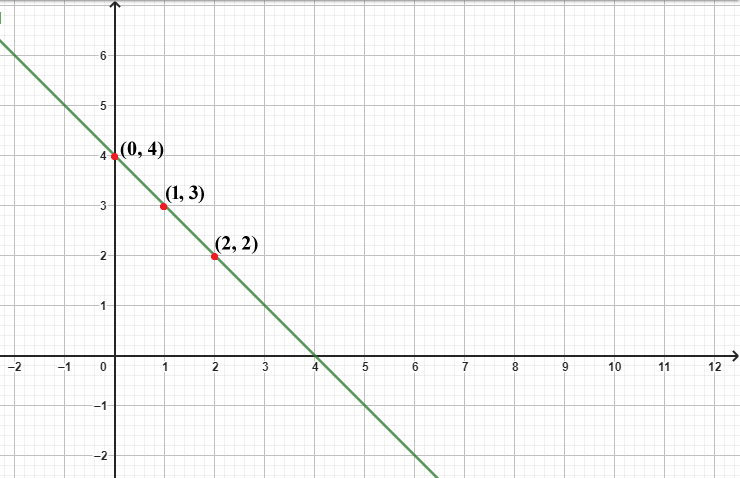
(ii) x – y = 2
⇒ y = x – 2
If we have x = 0, then y = 0 – 2 = -2
x = 2, then y = 2 – 2 = 0
∴ We get the following table:
| x | 0 | 2 |
| y | -2 | 0 |
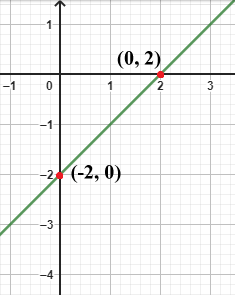
(iii) y = 3x
If we have x = 0, then y = 0
x = 1, then y = 3
∴ We get the following table:
| x | 0 | 1 |
| y | 0 | 3 |
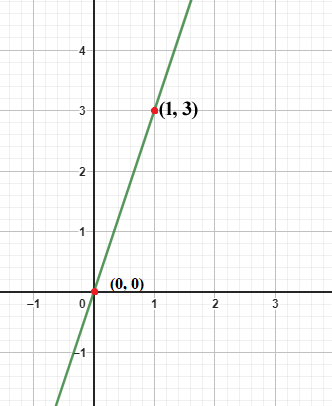
(iv) 3 = 2x + y
⇒ y = 3 – 2x
If we have x = 0, then y = 3 – 0 = 3
x = 1, then y = 3 – 2 = 1
∴ We get the following table:
| x | 0 | 1 |
| y | 3 | 1 |

2. Give the equations of two lines passing through (2, 14). How many more such lines are there, and why?
Answer – Point (2, 14) at which lines passing through.
We can think of framing equations that could satisfy the given point (2, 14) on the line.
It can be observed that point (2, 14) satisfies the equation 7x – y = 0 and x – y + 12 = 0.
Therefore, 7x – y = 0 and x – y + 12 = 0 are two lines passing through point (2, 14).
Since we know infinite lines can pass through a single point, therefore there are infinite more lines passing through the given point.
3. If the point (3, 4) lies on the graph of the equation 3y = ax+7, find the value of a.
Answer – The given equation is 3y = ax + 7
According to the question, x = 3 and y = 4
Now, substituting the values of x and y in the equation 3y = ax + 7,
We get,
(3 × 4) = (a × 3) + 7
⇒ 12 = 3a + 7
⇒ 3a = 12 – 7
⇒ 3a = 5
⇒ a =
The value of a, if the point (3, 4) lies on the graph of the equation 3y = ax+7 is .
4. The taxi fare in a city is as follows: For the first kilometre, the fare is ₹8, and for the subsequent distance, it is ₹5 per km. Taking the distance covered as x km and total fare as ₹ y, write a linear equation for this information, and draw its graph.
Answer –
Total distance covered = x
Total fare = y
Fare for the first kilometre = 8 per km
Fare after the first 1 km = 5 per km
If x is the total distance, then the distance after one km = (x – 1)km
i.e., fare after the first km = 5(x – 1)
According to the question,
The total fare = Fare of first km + fare after the first km
y = 8 + 5(x – 1)
y = 8 + 5(x – 1)
y = 8 + 5x – 5
y = 5x + 3
Solving the equation,
When x = 0,
y = 5x + 3
y = 5×0+3
y = 3
When y = 0,
y = 5x + 3
o = 5x+3
5x = -3
x = -3/5
| x | 0 | – |
| y | 3 | 0 |
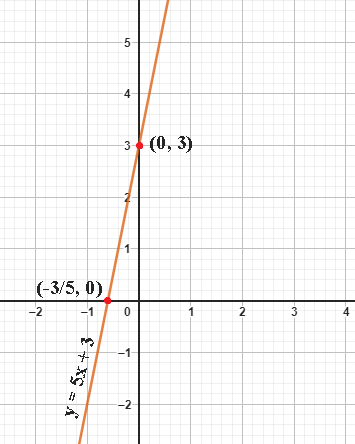
5. From the choices given below, choose the equation whose graphs are given in Fig. 4.6 and Fig. 4.7.
| For Fig. 4. 6 | For Fig. 4. 7 |
| (i) y = x | (i) y = x + 2 |
| (ii) x + y = 0 |
(ii) y = x – 2 |
| (iii) y = 2x |
(iii) y = –x + 2 |
| (iv) 2+3y = 7x |
(iv) x+2y = 6 |
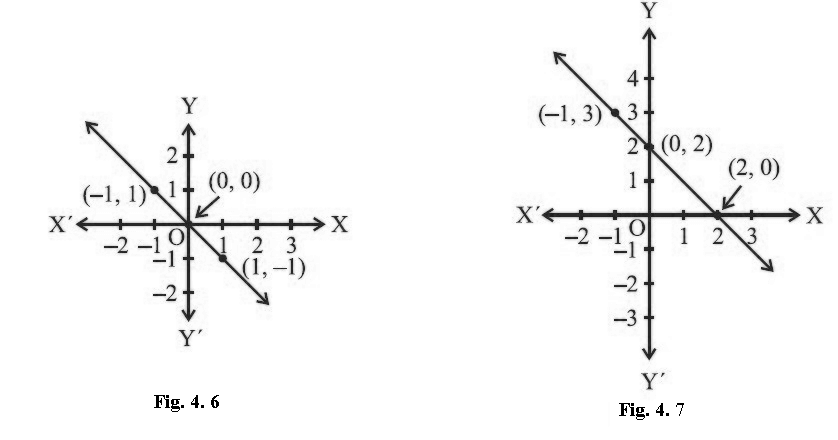
Answer – The points given in figure 4.6 are (0, 0), (-1, 1), (1, -1)
Substituting the values for x and y from these points in the equations, we get,
(i) y = x
(0, 0)
⇒ 0 = 0
(-1, 1)
⇒ -1 ≠ 1 equation not satisfied
(1, -1)
⇒ 1 ≠ -1 equation not satisfied
(ii) x + y = 0
(0, 0)
⇒ 0 + 0 = 0
(-1, 1)
⇒ -1 + 1 = 0
(1, -1)
⇒ 1 + (-1) =0
(iii) y = 2x
(0, 0)
⇒ 0 = 2×0 = 0
(-1, 1)
⇒ 1 = 2×(-1)
⇒ 1 ≠ -2 equation not satisfied
(1, -1)
⇒ -1 = 2×1
-1 ≠ 2 equation not satisfied
(iv) 2 + 3y = 7x
(0, 0)
⇒ 2 + (3×0) = 7×0
⇒ 2 ≠ 0 equation not satisfied
(-1, 1)
⇒ 2 + (3×1) = 7×-1
⇒ 5 ≠ -7 equation not satisfied
(1, -1)
⇒ 2 + (3×-1) = 7×1
⇒ -1 ≠ 7 equation not satisfied
Equation (ii) , satisfies these solutions.
For Fig. 4. 7
The points given in figure 4.7 are (0,2), (2,0), (-1,3)
Substituting the values for x and y from these points in the equations, we get,
(i) y = x + 2
(0, 2)
⇒ 2 = 0 + 2
2 = 2
(2, 0)
⇒ 0 = 2+2
⇒ 0 ≠ 4 equation not satisfied
(-1, 3)
⇒ 3 = -1 + 2
⇒ 3 ≠ 1 equation not satisfied
(ii) y = x–2
(0, 2)
⇒ 2 = 0 – 2
⇒ 2 ≠ -2 equation not satisfied
(2, 0)
⇒ 0 = 2–2
⇒ 0= 0
(-1, 3)
⇒ 3 = –1–2
⇒ 3 ≠ –3 equation not satisfied
(iii) y = –x + 2
(0, 2)
⇒ 2 = -0 + 2
⇒ 2 = 2
(2, 0)
⇒ 0 = -2 + 2
⇒ 0 = 0
(-1, 3)
⇒ 3 = -(-1) + 2
⇒ 3 = 3
(iv) x + 2y = 6
(0, 2)
⇒ 0 + (2×2) = 6
⇒ 4 ≠ 6 equation not satisfied
(2, 0)
⇒ 2 + (2×0) = 6
⇒ 2 ≠ 6 equation not satisfied
(-1, 3)
⇒ -1 + (2×3) = 6
⇒ 5 ≠ 6 equation not satisfied
Equation (iii) , satisfies these solutions.
6. If the work done by a body on application of a constant force is directly proportional to the distance travelled by the body, express this in the form of an equation in two variables and draw the graph of the same by taking the constant force as 5 units. Also, read from the graph the work done when the distance travelled by the body is
(i) 2 units
(ii) 0 unit
Answer – We can consider distance traveled by the body and the work done as ‘x’ and ‘y’ respectively and then apply the direct proportion property.
Let the distance traveled and the work done by the body be x and y respectively.
The constant force applied to the body is 5 units.
Work done ∝ distance traveled.
Hence, y ∝ x
y = kx ——————-Equation (1)
Where k is the constant force applied on the body, given as 5. Thus, y = 5x.
By substituting different values of x in equation (1) we get different values for y
When x = 0, y = 0
When x = 2, y = 10
| x | 0 | 2 |
| y | 0 | 10 |
The graph of the line represented by the given equation is shown below.
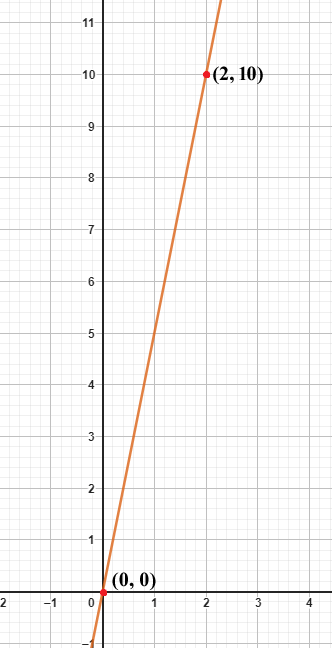
(i) From the graphs, it can be observed that the value of y corresponding to x = 2 is 10 units. This implies that the work done by the body is 10 units when the distance traveled by it is 2 units.
(ii) From the graphs, it can be observed that the value of y corresponding to x = 0 is 0. This implies that the work done by the body is 0 units when the distance traveled by it is 0 units.
7. Yamini and Fatima, two students of Class IX of a school, together contributed ₹ 100 towards the Prime Minister’s Relief Fund to help the earthquake victims. Write a linear equation which satisfies this data (You may take their contributions as ₹ x and ₹ y). Draw the graph of the same.
Answer – We can assume Yamini and Fatima’s contributions as ₹ x and ₹ y respectively, and form a linear equation.
Let the amount that Yamini and Fatima have contributed individually be ₹ x and ₹ y respectively towards the Prime Minister’s Relief Fund.
The total amount contributed by Yamini and Fatima together is = ₹ 100
Therefore, x + y = 100
On transposing, y = 100 – x
This is a linear equation in two variables of the form ax + by + c = 0
Let us consider this y = 100 – x ——— Equation (1)
By substituting different values of x in the equation (1), we get different values for y
When x = 0, y = 100
When x = 50, y = 50
When x = 100, y = 0
Thus, we have the following table with all the obtained values of x and y:
| x | 0 | 50 | 100 |
| y | 50 | 50 | 0 |
The graph of the line represented by the given equation is as shown.
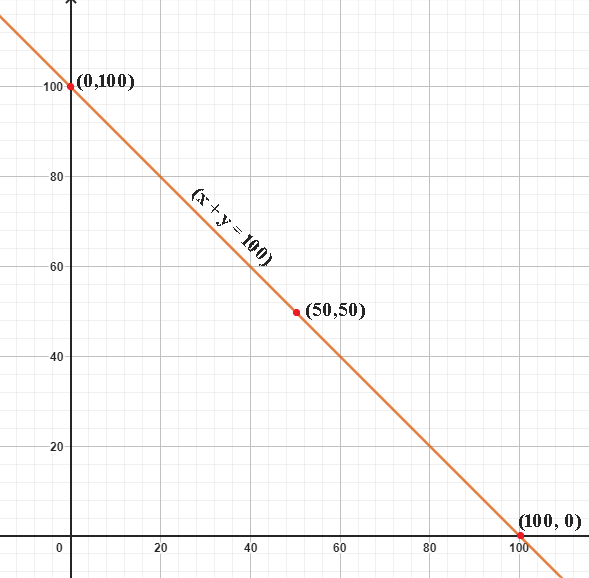
Here, variables x and y are representing the amount contributed by Yamini and Fatima respectively and these quantities cannot be negative. Hence, only those values of x and y which are lying in the 1st quadrant are considered.
8. In countries like USA and Canada, the temperature is measured in Fahrenheit, whereas in countries like India, it is measured in Celsius. Here is a linear equation that converts Fahrenheit to Celsius:
(i) Draw the graph of the linear equation above using Celsius for the x-axis and Fahrenheit for the y-axis.
Answer – According to the question,
We get,
When C = 0, F = 32
When C = -10 , F = 14
The points to be plotted are (0, 32), (-10, 14)
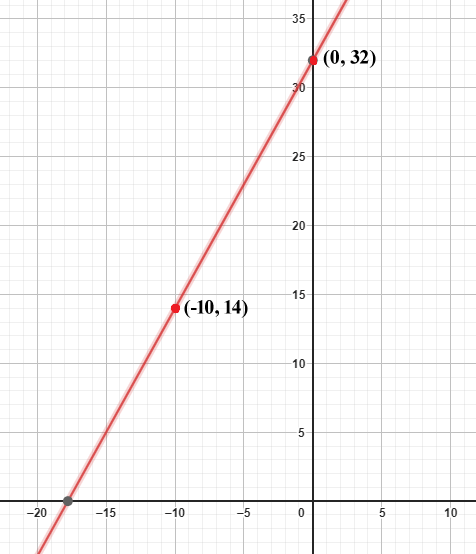
(ii) If the temperature is 30°C, what is the temperature in Fahrenheit?
Answer – When C = 30,
F = + 32
= (9×6)+32
= 54 + 32
= 86oF
(iii) If the temperature is 95°F, what is the temperature in Celsius?
Answer – When F = 95,
=35oC
(iv) If the temperature is 0°C, what is the temperature in Fahrenheit, and if the temperature is 0°F, what is the temperature in Celsius?
Answer – When C = 0,
= 0 + 32
= 32oF
When F = 0,
0 = C + 32
C = 0 – 32
C = -32
C =
= -17.7777
=-17.8oC
(v) Is there a temperature which is numerically the same in both Fahrenheit and Celsius? If yes, find it.
Answer – When F = C,
C = C + 32
C – C = 32
C =32
C = 32
C =
= – 40oC
Hence, -40o is the temperature which is numerically the same in both Fahrenheit and Celsius.

Leave a Reply